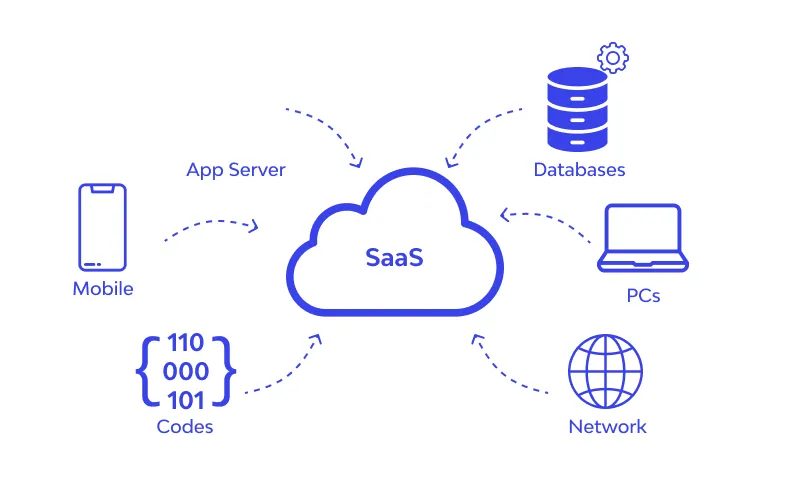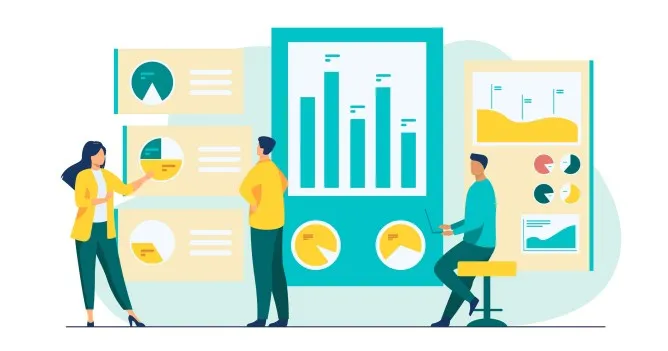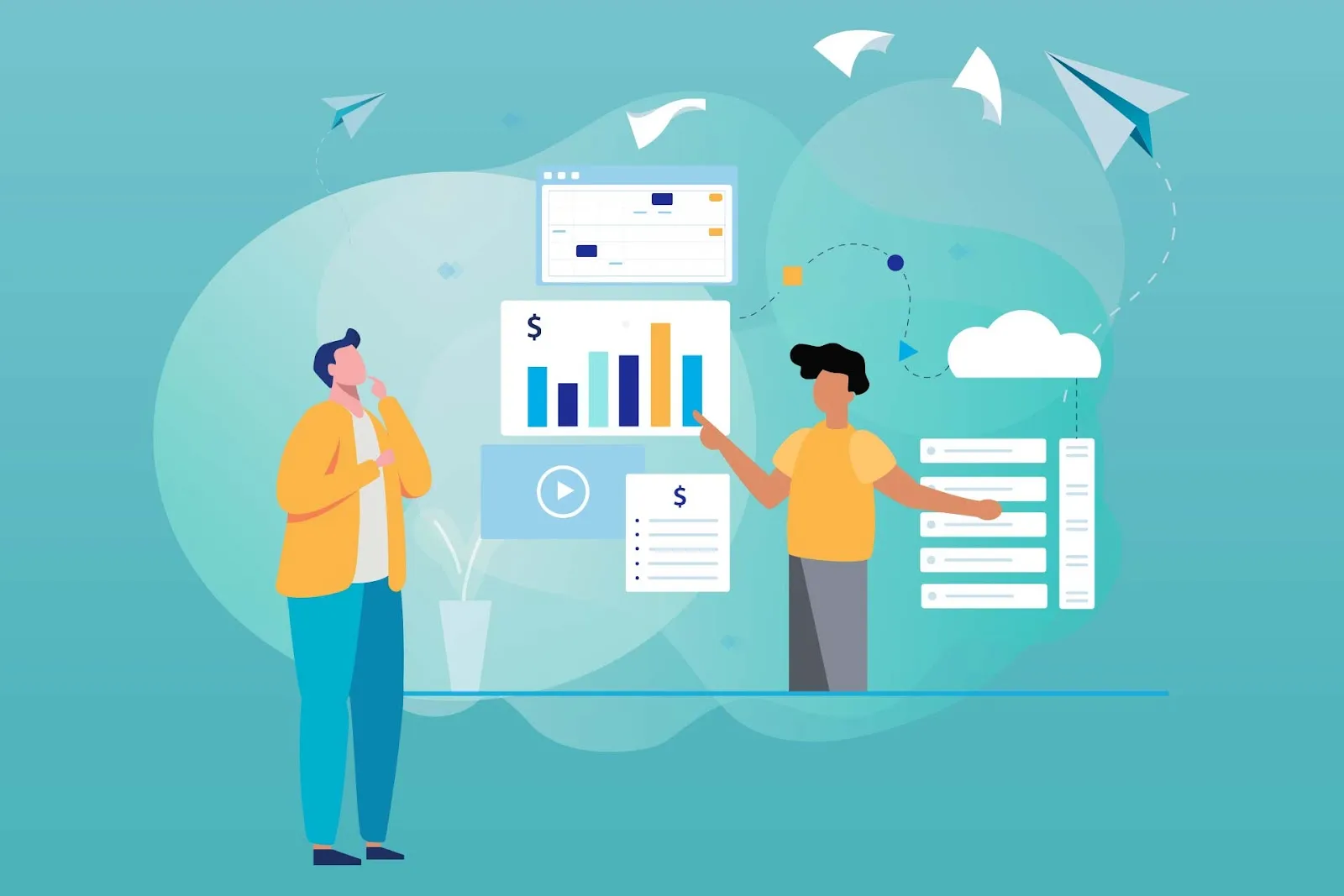Selling software as a service (SaaS) is all about providing solutions that customers can rely on every day. Unlike traditional software, SaaS is subscription-based, meaning the focus isn’t just on selling a product but building long-term customer relationships.
Did you know that the average SaaS company spends 15-20% of its revenue on customer acquisition? This makes understanding the SaaS sales process and customer lifetime value essential for sustainable growth. To succeed, sales reps need to connect with potential customers by addressing their pain points and showing how the solution fits their needs.
In this guide, we’ll break down the SaaS sales cycle, explore actionable strategies, and help you simplify complex challenges for better outcomes. Let’s dive in!
What Is SaaS?

SaaS, or Software as a Service, is a subscription-based software delivery model where users access applications through the internet rather than installing them locally.
SaaS companies focus on providing scalable solutions that meet customer needs, offering flexibility with subscription-based pricing models. Customers benefit from reduced upfront costs, easy updates, and access to essential features anytime.
SaaS products are designed to drive customer satisfaction by delivering measurable value, enabling businesses to address pain points efficiently. The SaaS sales process emphasizes customer retention, customer lifetime value, and long-term relationships, making it an essential part of the modern sales cycle for businesses.
Why Is Understanding the SaaS Sales Process Essential?

1. Clarifies the Sales Cycle: Knowing the SaaS sales cycle helps businesses streamline each stage, from lead generation to customer onboarding.
2. Improves Customer Retention: A well-defined sales process highlights how to reduce customer churn and extend customer lifetime value.
3. Aligns Sales Teams: It ensures sales teams and SaaS sales reps work effectively to achieve common goals.
4. Supports Revenue Growth: Understanding recurring revenue models like annual recurring revenue (ARR) helps improve financial predictability.
5. Focuses on Customer Needs: By focusing on customer satisfaction and value propositions, SaaS businesses deliver better results.
How Does the SaaS Sales Cycle Work

1. Prospecting and Lead Generation
The SaaS sales cycle starts with identifying potential customers. Using tools like CRM systems and targeting the right audience ensures you're reaching prospects who match your ideal customer profile.
Effective lead generation focuses on capturing the attention of potential customers through free trials, customer access portals, or targeted marketing campaigns.
Sales teams also look at web-based software solutions to track prospects’ interest and engagement.
2. Qualifying Leads
Once leads are generated, sales reps evaluate their potential. Key metrics like customer acquisition cost and average purchase value help determine if a lead is worth pursuing.
SaaS companies focus on qualifying leads that fit their subscription-based pricing model and offer long-term revenue potential.
This step helps filter prospects who are more likely to subscribe and benefit from the SaaS product.
“Never Miss a Lead with Alore’s Advanced Reply Handling and Automated Follow-Ups"
3. Presenting the Solution
The next stage involves presenting the SaaS solution to potential customers. Sales teams emphasize the value proposition of the product, showcasing how it solves specific challenges.
Selling web-based software effectively requires highlighting features like customer relationship management tools, SaaS sales models, and consultative selling strategies.
Sales reps use demos and free trials to help prospects understand how the solution fits their needs.
4. Handling Objections
During this phase, sales reps address customer concerns, such as pricing or technical compatibility. Transactional sales models or flexible subscription options are often presented to overcome objections.
SaaS sales specialists focus on clear communication and provide evidence, such as customer satisfaction rates or case studies, to build trust and confidence in the solution.
5. Closing the Deal
The goal here is to secure the commitment. Whether through annual contracts or monthly recurring revenue plans, the sales model must align with customer preferences.
SaaS companies often leverage sales compensation strategies to encourage sales reps to close deals effectively.
6. Onboarding and Implementation
After closing the deal, the onboarding process begins. This step ensures the customer understands the product and can use it seamlessly.
SaaS companies focus on providing customer success teams to help with implementation, ensuring customers feel supported from day one.
7. Retention and Upselling
Retention is key to the SaaS industry, where customer lifetime value plays a critical role. By offering upselling opportunities and emphasizing the long-term benefits of the product, SaaS companies reduce customer churn. Regular follow-ups, free trials for new features, and a focus on customer satisfaction help maintain strong relationships and generate recurring revenue.
This structured approach ensures a smooth SaaS sales cycle while prioritizing customer needs at every step.
How Can Sales Reps Improve SaaS Sales Outcomes?

1. Know Customer Pain Points
Understanding customer pain points is the foundation of successful SaaS sales. Sales reps should explore specific challenges potential customers face, such as managing customer lifetime or reducing customer churn.
Using SaaS sales metrics and tools like customer relationship management systems, reps can identify trends and focus on solving real issues.
This approach not only demonstrates empathy but also positions the SaaS product as a tailored solution.
2. Master Your SaaS Product
Sales reps must deeply understand the SaaS software they’re selling. By mastering the product’s features and use cases, they can confidently address customer objections.
This includes highlighting benefits like subscription-based pricing models, integration capabilities, and how the product aligns with the customer’s goals.
In-depth product knowledge allows reps to discuss enterprise sales models, free trials, or specific SaaS sales strategies with authority.
3. Personalize Your Pitch
A one-size-fits-all approach rarely works in SaaS sales. Reps should personalize their pitch by aligning the SaaS product with the customer's industry, needs, and pain points.
For example, potential customers in enterprise SaaS sales may require tailored solutions, while small businesses might focus on affordability.
Using insights from sales cycles and SaaS sales professionals, reps can craft pitches that resonate with their audience.
4. Use Data for Insights
Data is a powerful tool in improving SaaS sales outcomes. By leveraging essential SaaS sales metrics, reps can evaluate customer acquisition costs, customer lifetime value, and sales performance.
SaaS companies often provide tools to measure metrics like monthly recurring revenue or annual recurring revenue.
Analyzing this data allows reps to identify potential customers and fine-tune their sales approach.
5. Build Strong Relationships
Long-term relationships are key to SaaS success. Reps should prioritize customer satisfaction by being proactive and accessible.
Building trust involves regular follow-ups, offering value through free trials or demos, and addressing issues promptly.
For high-value clients, consultative selling can help align the product with the customer’s broader business goals.
6. Handle Objections Smartly
Customer objections are inevitable, but handling them effectively can make a difference. Sales reps can address concerns by presenting data, such as sales funnel progress, case studies, or real-world examples.
For objections about pricing, transactional sales models or flexible contract terms like annual contracts can offer reassurance. Clear communication and active listening are crucial in this step.
7. Leverage Sales Tools
SaaS businesses provide a range of tools to help sales teams succeed. Sales reps can use customer success platforms, CRM software, and analytics tools to streamline their processes.
These tools simplify tracking sales cycles, managing sales reps’ tasks, and enhancing customer experience.
For enterprise SaaS sales, advanced tools may also assist in lead scoring and managing complex deals.
8. Work with Customer Success
Collaboration with the customer success team ensures better customer retention and satisfaction. SaaS sales reps can share insights from the sales process to help the success team deliver tailored onboarding experiences.
Teams working together can identify upselling opportunities, address challenges early, and reduce customer churn.
This alignment strengthens the customer relationship and contributes to the long-term success of SaaS companies.
By focusing on these strategies, SaaS sales reps can drive better outcomes, ensuring that customers not only subscribe but remain loyal and satisfied. The emphasis on collaboration, data, and personalization creates a sales approach that is effective and sustainable.
What Role Do SaaS Companies Play in the Sales Process?

- SaaS companies create flexible sales models to match customer needs and goals.
- They equip sales reps with the skills to address objections and provide tailored solutions.
- SaaS companies track key metrics to make data-driven decisions in the sales process.
- They enhance the buying experience through free trials and customer-focused strategies.
- SaaS companies support sales teams with tools and strategies to simplify the sales journey.
Importance of Selling Value Over Products

1. Focus on Customer Outcomes
- Selling SaaS products means understanding and focusing on what customers hope to achieve.
- SaaS businesses thrive by aligning their offerings with customer outcomes rather than just selling features.
- For example, enterprise sales often require demonstrating how the product improves efficiency or reduces costs for large organizations.
- This focus builds trust and helps customers feel that their needs are truly being met.
2. Emphasize ROI Over Features
- SaaS companies should prioritize showcasing the return on investment (ROI) rather than overwhelming prospects with features.
- Highlighting metrics like average customer lifespan and long-term savings resonates more with decision-makers.
- Whether it’s B2B SaaS or selling software to smaller businesses, demonstrating value through ROI helps customers justify their purchase and builds confidence in the product.
3. Solve Specific Customer Challenges
- Understanding the unique challenges customers face is essential. Target markets in SaaS often have specific pain points that need addressing.
- For instance, existing customers in a longer sales cycle may struggle with integrating new solutions.
- SaaS selling should focus on how the product directly solves these challenges, making it easier for customers to adopt and continue using the software.
4. Showcase Real-World Use Cases
- Real-world use cases help customers see the practical applications of SaaS products.
- Sales demos and real-life scenarios provide clarity on how the software works and delivers value.
- Whether it’s selling web-based software or managing enterprise sales models, examples allow potential customers to visualize the benefits in their own business context, making the sales process smoother.
5. Highlight Long-Term Benefits
- Long-term benefits like lower annual contract value or a consistent revenue stream through subscription-based pricing models appeal to many customers.
- SaaS businesses should emphasize how their products create sustained improvements over time, such as reduced customer acquisition costs or increased operational efficiency.
- For enterprise sales and B2B SaaS models, this long-term focus is often a key selling point.
6. Deliver Personalized Value Propositions
- Personalization is a powerful tool in SaaS sales. Each customer has unique needs, and tailoring the pitch ensures they feel understood.
- For instance, in B2B SaaS sales, a sales strategy might focus on integrating the product into existing workflows.
- Delivering a personalized value proposition not only improves customer satisfaction but also lays the foundation for a longer-lasting relationship.
By focusing on selling value over features, SaaS companies position themselves as partners in their customers’ success. This approach not only drives sales but also strengthens customer loyalty, helping SaaS businesses thrive in a competitive landscape.
How to Retain Customers in SaaS Sales?

1. Simplify Onboarding
Onboarding is the first impression customers have with your product. SaaS businesses should focus on making this process as simple and clear as possible.
Providing easy-to-follow guides or offering a customer success team can help customers get started smoothly.
Whether it’s providing access to free trials or SaaS sales demos, a smooth onboarding experience sets the tone for long-term success.
2. Provide Proactive Support
Customer support shouldn’t only be reactive. Offering proactive support shows customers that you care about their experience and success with your SaaS product.
A customer success team that regularly checks in, offers troubleshooting advice, or provides product updates can build trust.
This approach helps to prevent churn and enhances customer satisfaction.
3. Showcase Delivered Value
Regularly reminding customers of the value they’re receiving helps reinforce their decision to choose your SaaS product.
Highlight how the product is solving their pain points and delivering on its promises.
Whether it’s showing improvements in efficiency, customer lifetime value, or how the software integrates into their existing workflow, showcasing value ensures customers remain committed.
4. Reward Customer Loyalty
Loyal customers are invaluable. Offering incentives for long-term usage, such as discounted subscription fees, exclusive features, or personalized solutions, can encourage customers to stay.
Implementing a reward program or offering early access to new SaaS features shows appreciation for their continued business.
5. Track Usage Trends
By tracking usage trends, SaaS companies can identify customers who may be underusing the product or facing issues.
This insight allows businesses to offer tailored solutions or guidance before customers even reach out.
Monitoring data like monthly recurring revenue (MRR) or SaaS sales metrics helps spot patterns and predict retention risks.
6. Use Feedback to Improve
Actively seeking and using customer feedback helps refine your SaaS product and sales process. Customer satisfaction surveys, NPS scores, and direct feedback from sales reps provide valuable insights.
Using this data to improve the product ensures customers feel heard and valued, which strengthens relationships and reduces churn.
These strategies, when executed well, can ensure that customers not only stay but continue to derive value from the SaaS offering, leading to lasting relationships and business growth.
Which Tools Can Simplify SaaS Sales?

1. CRM Platforms for Customer Management
CRM platforms centralize all customer information in one place, making it easier to manage relationships and track interactions. These platforms allow sales teams to follow up on leads, monitor sales progress, and stay organized throughout the sales cycle.
How it helps:
- Centralizes customer data for easy access and management.
- Enables sales reps to track interactions, sales stages, and opportunities.
- Improves follow-up efficiency and response times with automated reminders.
- Strengthens customer relationships by maintaining detailed records of past interactions.
2. Sales Automation Tools for Efficiency
Sales automation tools reduce the time spent on repetitive tasks by automating emails, follow-ups, and other actions. This allows sales teams to focus more on engaging with potential customers and closing deals.
How it helps:
- Automates lead nurturing and follow-up tasks, saving time for sales reps.
- Speeds up the sales cycle by eliminating manual processes.
- Ensures consistent communication with prospects through automated email sequences.
- Reduces human errors and improves overall process efficiency.
3. Analytics Tools for Data-Driven Decisions
Analytics tools track key performance metrics such as customer lifetime value, monthly recurring revenue (MRR), and sales performance. These insights help SaaS businesses make informed decisions to improve their sales strategies.
How it helps:
- Provides insights into sales performance and key SaaS metrics.
- Helps sales teams identify trends and adjust strategies accordingly.
- Tracks customer engagement, enabling a targeted approach to each prospect.
- Improves forecasting and allows for better allocation of resources.
4. Communication Tools for Better Engagement
Communication tools help sales teams maintain constant and clear contact with prospects and customers, whether through emails, chat, or video calls. They foster better relationships and ensure timely responses to customer needs.
How it helps:
- Facilitates real-time communication with customers via chat or video calls.
- Allows seamless collaboration among sales teams through integrated messaging platforms.
- Strengthens relationships through personalized follow-up and proactive communication.
- Enables virtual product demos, helping customers understand the software’s value.
5. Onboarding Tools for Seamless Integration
Onboarding tools ensure new customers can easily integrate and start using the SaaS product. These tools provide guidance, tutorials, and help documentation to ensure customers have a smooth transition from signing up to fully utilizing the product.
How it helps:
- Provides step-by-step guidance, reducing confusion during the setup process.
- Increases customer satisfaction by offering easy-to-understand tutorials.
- Helps customers quickly realize the value of the product through a guided onboarding experience.
- Reduces churn by improving initial customer engagement and product adoption.
6. Customer Success Tools for Retention
Customer success tools monitor the health of customer accounts, track usage patterns, and offer proactive support. These tools help identify customers at risk of churning and provide the necessary assistance to improve satisfaction and retention.
How it helps:
- Tracks customer engagement and usage trends to identify potential issues early.
- Provides proactive solutions to ensure customers are getting the most out of the product.
- Helps sales and customer success teams work together to deliver personalized value.
- Improves retention by addressing customer concerns before they lead to churn.
By using these tools, SaaS sales teams can enhance efficiency, improve customer engagement, and ultimately build long-term, successful relationships. Each tool plays an essential role in simplifying the sales process and contributing to overall success.
What Are the Key Challenges in the SaaS Sales Cycle?

1. Long Sales Cycles
SaaS sales cycles can often be long, especially when selling to enterprise businesses or targeting B2B SaaS markets. The process from initial contact to final sale may take months due to multiple decision-makers, complex needs, and lengthy evaluations.
This delay in closing deals can be frustrating for sales teams, especially when prospects show initial interest but fail to convert quickly.
Solution:
- Focus on selling SaaS by demonstrating clear value early on, using product demos and free trials.
- Tailor the sales pitch to highlight longer sales cycles and offer flexible subscription-based pricing models to address potential hesitations.
- Nurture leads by regularly staying in touch and using sales teams to address concerns and provide personalized follow-up.
2. High Customer Churn
High customer churn can significantly impact the growth of a SaaS business. When customers leave too soon, it not only hurts revenue but also wastes resources spent on customer acquisition.
Many SaaS companies face this challenge when clients don't fully realize the value of the product or when their initial expectations aren't met.
Solution:
- Focus on customer retention strategies, such as providing excellent support, onboarding, and personalized solutions.
- Regularly track customer engagement through SaaS sales metrics and identify at-risk customers early.
- Provide value through regular updates and longer sales cycles, ensuring clients see the long-term benefits of the product.
3. Pricing Objections
SaaS businesses often face pricing objections from potential clients who feel that the product is too expensive for their budget.
This is especially true when trying to convince small businesses or startups to sign up for a SaaS service with a high monthly or annual recurring cost.
Solution:
- Offer tiered pricing models or annual contract value discounts to make the service more affordable.
- Position the product’s value by emphasizing the SaaS business's return on investment (ROI) and the long-term savings it offers.
- Use customer success stories to show how the product addresses pain points more effectively than alternatives, demonstrating the true value.
4. Complex Solutions Explained
SaaS products can sometimes be complex and difficult for customers to fully grasp, especially when they involve integrations or advanced features. Explaining these solutions can be a challenge, particularly if the customer is not tech-savvy or if they are overwhelmed by the product's features.
Solution:
- Simplify the sales pitch by focusing on the most impactful features and how they directly solve the customer's pain points.
- Offer clear documentation, video tutorials, and dedicated support from SaaS sales reps to guide customers through complex features.
- Use selling web-based software examples to explain use cases in simple, relatable terms.
5. Retention After Onboarding
Many SaaS businesses successfully onboard new customers but struggle to retain them in the long run. The customer might initially be engaged, but after the onboarding process, they may not see immediate value or might not be fully committed to the service.
Solution:
- Provide continuous value and personalized support through customer success teams, ensuring that customers experience the full benefits of the software.
- Track customer lifetime and proactively reach out to assist with any challenges during the early stages.
- Regularly check-in and provide solutions to maximize the customer’s return on investment, ensuring they are fully integrated into the SaaS business's ecosystem.
6. Standing Out in the Market
The SaaS market is crowded, and it can be difficult for new or small SaaS businesses to differentiate themselves from the competition. Many products are similar, and customers may struggle to choose between several options that meet their needs.
Solution:
- Focus on creating a strong value proposition that clearly demonstrates what makes your product unique.
- Offer personalized customer experiences through consultations and tailored solutions, ensuring clients see why selling SaaS with your company is the best choice.
- Highlight customer success stories to show how your product has effectively addressed customer challenges, helping your SaaS business stand out in a crowded market.
By tackling these challenges head-on, SaaS companies can create more efficient sales cycles, improve customer satisfaction, and stand out in an ever-growing market. The right approach can ensure long-term success and sustainability.
Conclusion
Selling Software as a Service isn't just about making a sale, it's about building relationships, delivering value, and creating long-term success for both your customers and your business. By understanding the SaaS sales process and the tools that help streamline it, you can effectively address challenges like long sales cycles, customer churn, and pricing objections.
Focus on providing real value through personalized solutions, proactive support, and by measuring success with data-driven insights. Remember, SaaS is not just a product; it’s a service that evolves with your customer’s needs. Keep refining your approach, and the results will speak for themselves.

.webp)





.jpg)

